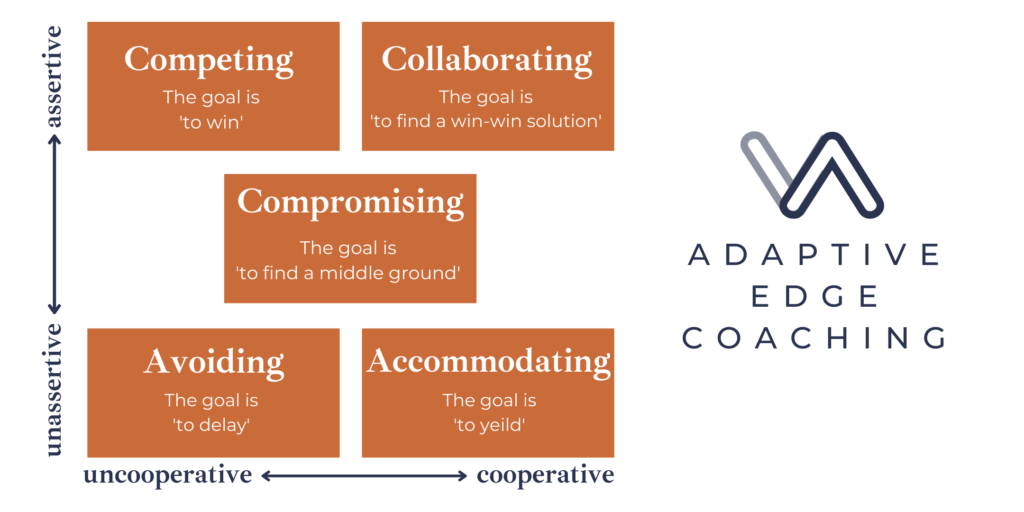One common theme that emerges while working with my clients, in both personal and professional settings, is that they often continue to have the same types of conflicts, over and over. Naturally these experiences can elicit hopelessness and toxic stress. People are inclined to quit on relationships or leave positions within companies when things reach the level of unbreakable patterns, but I have seen relationships repaired drastically simply by parties having some principled conversations about conflict. In this post I will teach you about the 5 different conflict styles, how to recognize them, and which types are best for certain situations.
The Thomas-Kilman model is broken down into there are five styles, or modes, of conflict. The key differences between these conflict styles is that they all measure up a bit differently on the scales of assertiveness and cooperativeness. Below I will give you a preview of the five styles and give examples of how each can be used effectively in different professional and personal situations.
Competing (forcing) is assertive and uncooperative. It is the style of conflict most associated with power. It involves putting your own interests above others’ concerns using any suitable means to win your position. It is often associated with aggressiveness and bullying, but it can also be an effective way to stand up for a what is right. It is useful:
· When quick, decisive action is vital – in an emergency
· For executing unpopular decisions that need implementing
· For separating yourself from individuals who may try to take advantage of you, especially if you use a more passive conflict style
Collaborating (problem solving) is high on both assertiveness and cooperativeness. If done right, both parties will feel as though they are having their needs fully met. Collaboration involves entering a conflict focused on interests rather than outcomes, and brainstorming solutions without digging in your heels. Collaborating can be very difficult as it often requires a good deal of creativity to explore options that satisfy both people. Collaborating is best when:
· When you need to find an integrative solution and the concerns of both parties are too important to be compromised
· When you want to gain commitment by involving more people and their concerns in a decision or outcome
· When you need to be introspective and work through hard feelings that have been interfering with a relationship
Compromising (sharing) is middle of the road when it comes to both assertiveness and cooperation. Unlike collaborating which demands both parties have most, if not all, needs met, the compromise meets at least some of the needs of each stakeholder while leaving some out. Issues are not explored as in depth as they would be in collaborating, and so compromising can be beneficial when there is not a great deal of time at hand. Compromising involves asking yourself, what is most important to you, and what are you willing to give up? Compromise when:
· You have an important goal but being more assertive may risk disrupting a good relationship
· You need to settle on a temporary arrangement or agreement on an issue
· Collaboration or competition fails
Avoiding (withdrawing) is the least assertive and least cooperative conflict style. A person considers neither their own concerns nor the concerns of the other party. The conflict is either not addressed or it is postponed until a better time. Oftentimes, avoidance is used for sidestepping an unpleasant issue. While avoidance and being unassertive can seem weak, avoidance is good when:
· The potential costs of confronting an issue outweigh the benefits of its resolution
· Gathering more information is necessary
· You perceive that you have no chance of satisfying your concerns
Accommodating (smoothing) is unassertive and cooperative and it is the opposite of competing. This involves putting your own interests and concerns by the wayside in order to meet the needs of the other person. Accommodating can be too self-sacrificial, whereby someone obeys another person’s orders or yield’s to opposing points of view when it is not in their best interests to do so. It can take more benevolent forms such as charity or selflessness as well. Accommodate when:
· You want to build up social credits for later issues that are important to you
· You realize you are wrong – to allow a better solution to be considered
· The issue is much more important to the other person than it is to you
How have you seen each of the different conflict styles play out in your relationships? Are you using the correct style that each situation demands? With a bit of reflection and practice you can learn to match up the appropriate conflict style to fit any situation in order to live a much more productive and meaningful life. Check out our other blogs on communication or Contact me for more information about conflict style and assertiveness coaching!

